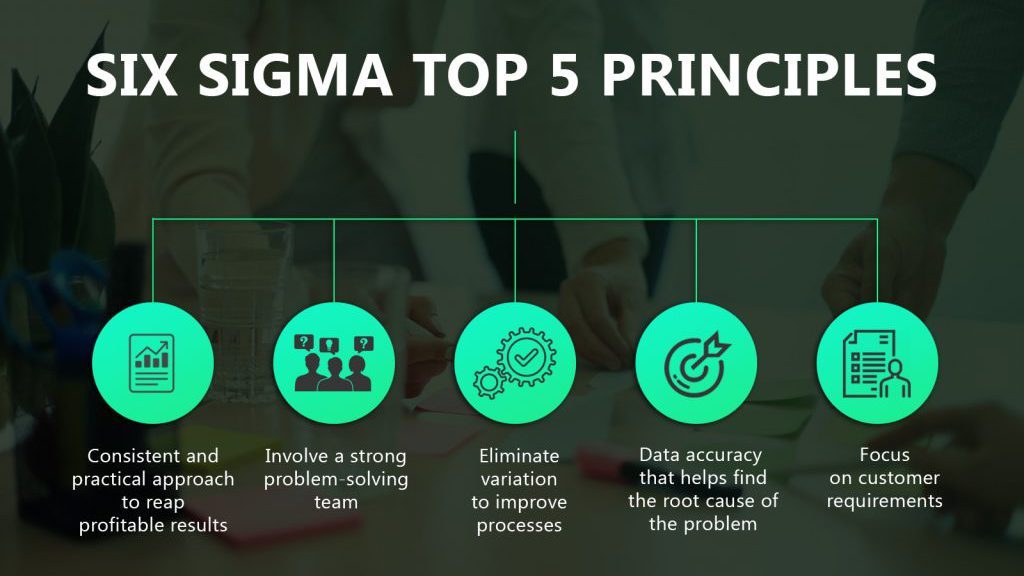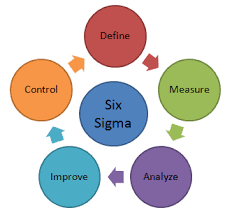
- Overview of Six Sigma Principles
- Beginning of Six Sigma
- Key Principles of Six Sigma
- Highlights of Six Sigma
- Key Concepts of Six Sigma
- Advantages of Six Sigma
- Conclusion
- Six Sigma began at Motorola in the mid 1980s, because of accomplishing 10X decrease in item disappointment levels in 5 years.
- Engineer Bill Smith created Six Sigma, yet passed on from a respiratory failure in the Motorola cafeteria in 1993, never knowing the extent of the frenzy and contention he had ignited.
- Six Sigma depends on different quality administration speculations (for example Deming’s 14 point for the board, Juran’s 10 stages on accomplishing quality).
- Giving need to clients’ s prerequisite
- Understanding the genuine course of working and utilizing broad devices and strategies to discover the specific reason for variety.
- Adopting a proactive strategy to decreasing variety and diligent improvement simultaneously.
- Include and prepare individuals in cross-practical groups
- Making organized, logical, and adaptable methodologies in critical thinking
- Certain activities keep individuals from skirting their obligations.
- Task tasks assist individuals with coming into the field of a similar interaction.
- A format outline assists with following the advancement of whether or not the interaction is moving as needs be.
- Six Sigma’s point is to dispose of waste and shortcoming, in this manner expanding consumer loyalty by conveying what the client is anticipating.
- Six Sigma follows an organized strategy, and plays characterized parts for the members.
- Six Sigma is an information driven strategy, and requires precise information assortment for the cycles being examined.
- Six Sigma is tied in with placing results on Financial Statements.
- Six Sigma is a business-driven, multi-layered organized methodology for − Further developing Processes, Bringing down Defects, Diminishing interaction changeability, Diminishing expenses, Expanding consumer loyalty, Expanded benefits.
- The word Sigma is a factual term that actions how far a given cycle strays from flawlessness.
- The focal thought behind Six Sigma: If you can quantify the number of “deserts” you have in an interaction, you can efficiently sort out some way to dispense with them and get as near “zero deformities” as could be expected and explicitly it implies a disappointment pace of 3.4 parts per million or 99.9997% great.
- Basic to Quality − Attributes generally essential to the client.
- Deformity − Failing to convey what the client needs.
- Process Capability − What your cycle can convey.
- Variety − What the client sees and feels.
- Stable Operations − Ensuring reliable, unsurprising cycles to further develop what the client sees and feels.
- Plan for Six Sigma − Designing to address client issues and interaction capacity.
- Six Sigma is just worried about decreasing imperfections.
- Six Sigma is a cycle for creation or designing.
- Six Sigma can’t be applied to designing exercises.
- Six Sigma utilizes challenging to-get measurements.
- Six Sigma is simply preparing.
- Creates supported achievement
- Puts forth an exhibition objective for everybody
- Upgrades worth to clients
- Speeds up the pace of progress
- Advances learning and cross-fertilization
- Executes vital change
Overview of Six Sigma Principles :-
In the era of globalization, all kinds of businesses (big industries to MSME/ small scale industries) are persisting in retaining or improving the quality standard of products or services to sustain in high competitiveness of the domestic or international market. In this topic, we are going to learn about Six Sigma Principles.
A single substantial incident of the quality standard may cause irredeemable damage to brand equity and consumer trust. That is why various quality management methodologies have been gaining popularity and acceptance throughout industries in due course of time. The notion of six sigma methodology has gained tremendous momentum and popularity across various industries. Thus, it is used as an advanced tool in quality management and process improvement for the last two decades.
Six Sigma is an approach of statistical tools and techniques emphasized on eliminating defects and reducing process variation. It was first scientifically implemented by Motorola in 1993, though the designation, Six Sigma, takes a standard deviation. Motorola implemented the term six sigma as process of defect-free 99.99966percent of the time, allowing only 3.4 defects over per million opportunities.
While Motorola applied this approach for its own operation, later, it became a catchword gradually and widely accepted as a standard measurement. The below table defines six sigma process calculation; the capability index, DPMO (Defects per million opportunities), and the implied performance at select levels are mentioned in this table.
Beginning of Six Sigma :-

Key Principles of Six Sigma :-
The achievement of the execution of Six Sigma depends on 5 key standards. These are –
1. Giving need on Customer’s necessity
Zero in on clients’ necessities is the most importantly standard of the six sigma process. Here the ‘nature of item or administration characterizes according to the point of view of the client’s perspectives. A business needs to gauge the quality norm as the clients do purposely. Six Sigma projects are started in view of clients’ worth and request, and it assists with working on the nature of the item or administration.
2. Understanding the interaction and recognize the main driver
It is important to have an unmistakable thought of the real course of working. For that reason you want to gather information or data from acknowledging how the genuine cycle functions. The information assortment rotates around talking individuals, mentioning the objective fact, and persistently posing inquiries till finding a fantastic solution. However, before information assortment, you should have an unmistakable perspective on the objective and what sort of information will be gathered.
Subsequent to getting information, you should dissect it to whether it gives the necessary knowledge on the thing you are looking for. In the event that, make an effort not to gather more data.Once gathered, you attempt to execute information in explaining the cycle and distinguishing the main driver of variety in quality. This quality variety might reason for imperfection of the item or administration.
3. Proactive methodology for lessening variety
An interaction can be distinct as a progression of stages where information sources are given to come by the ideal result. Six Sigma stresses a predictable outcome by normalizing the cycle. Through process normalization, you can decrease the varieties and will associate more productive results.
Subsequent to getting the sign of the reasons for varieties to make changes (if necessary) to the cycles to dispose of the varieties, on the off chance that any sort of step doesn’t increase the value of the interaction, simply destroy it at the start before it ends up being undeniable. As a matter of fact, these varieties might cause to make more imperfections underway. So the colleagues ought to be proactive to distinguish the main driver and make a move to kill the variety.
Every single part who is partner with the undertaking or creation should utilize an agenda to eliminate change from the normalized cycle, which assists with accomplishing the objective. They need to follow specific advances –
4. Include and prepare individuals
Profoundly capable colleagues and pioneers can drive the course of Six Sigma. To that end each part must be prepared around Six Sigma’s system, including estimation techniques and improvement devices, to assistant the objective. Furthermore, they need to foster relational abilities that they can discuss actually with collaborators and clients.
Like some other drive, here likewise individuals are the key drive. However, there is a distinction that Six Sigma confirms individuals’ ability and assigns like Yellow Belt, Green Belt, Black Belt, and Master Black Belt. Six Sigma acquires these phrasings from military workmanship. Like military workmanship, it never follows any hypothesis either; however it follows standards to associate a specific objective.
a. Ace Black Belt : A Master Black Belt is capably prepared in Six Sigma systems, measurable apparatuses, and the board processes. It is the obligation of a holder of an expert Black Belt testament to guide Black Belt and other colleagues through talking about or investigating different issues.
b. Dark Belt : A Black Belt gets the most significant level of preparing on the execution of measurable devices. The obligations relegated to Black Belt are making project plans, driving colleagues, and coordinating cross-useful tasks. Dark belts give preparing to other colleagues on Six Sigma methods like main driver examination, histogram, and so forth
c. Green Belt : Green Belts get preparing on DMAIC philosophy, measurable apparatuses, legitimate information assortment, and examination of gathered information. They report to Black Belt.
d. Yellow Belt : Yellow Belts should have a fundamental comprehension of the Six Sigma strategy. They take a mindful part at the hour of discovering the objective; even they gather information, yet they are not ordinarily associated with the investigation cycle.
5. Organized and adaptable methodology for development:
Six Sigma forms an organized and adaptable methodology for persistent improvement in processes. It has a reasonable philosophy of progress: DMAIC (Define, Measure, Analyze, Improve, and Control). Each phase of the DMAIC cycle has devices to decrease the fluctuation.Certain individuals see Six Sigma as a way of thinking that can gauge the cycles of a wide range of organizations.
Highlights of Six Sigma :-
Key Concepts of Six Sigma :-
At its center, Six Sigma spins around a couple of key ideas.
Our Customers Feel the Variance, Not the Mean. So Six Sigma zeros in first on diminishing interaction variety and afterward on further developing the cycle ability.
There are a few legends and false impressions encompassing Six Sigma. Some of them few are given beneath −
Advantages of Six Sigma :-
Six Sigma offers six significant advantages that draw in organizations −

Conclusion :-
The project management organisation use Six Sigma to reduce or eliminate faults in any process through a disciplined, data-driven approach. This method can be used to manufacturing, engineering, leadership, and any other function where a specialised procedure is required. DMAIC is the specific methodology of Six Sigma that walks project managers through a set step-by-step system to systematically identify defects, measure, analyze, improve, and control the process. Many organizations live and breathe by the methodologies of Six Sigma. These organizations have reported higher income, faster processes, and increased employee morale.





